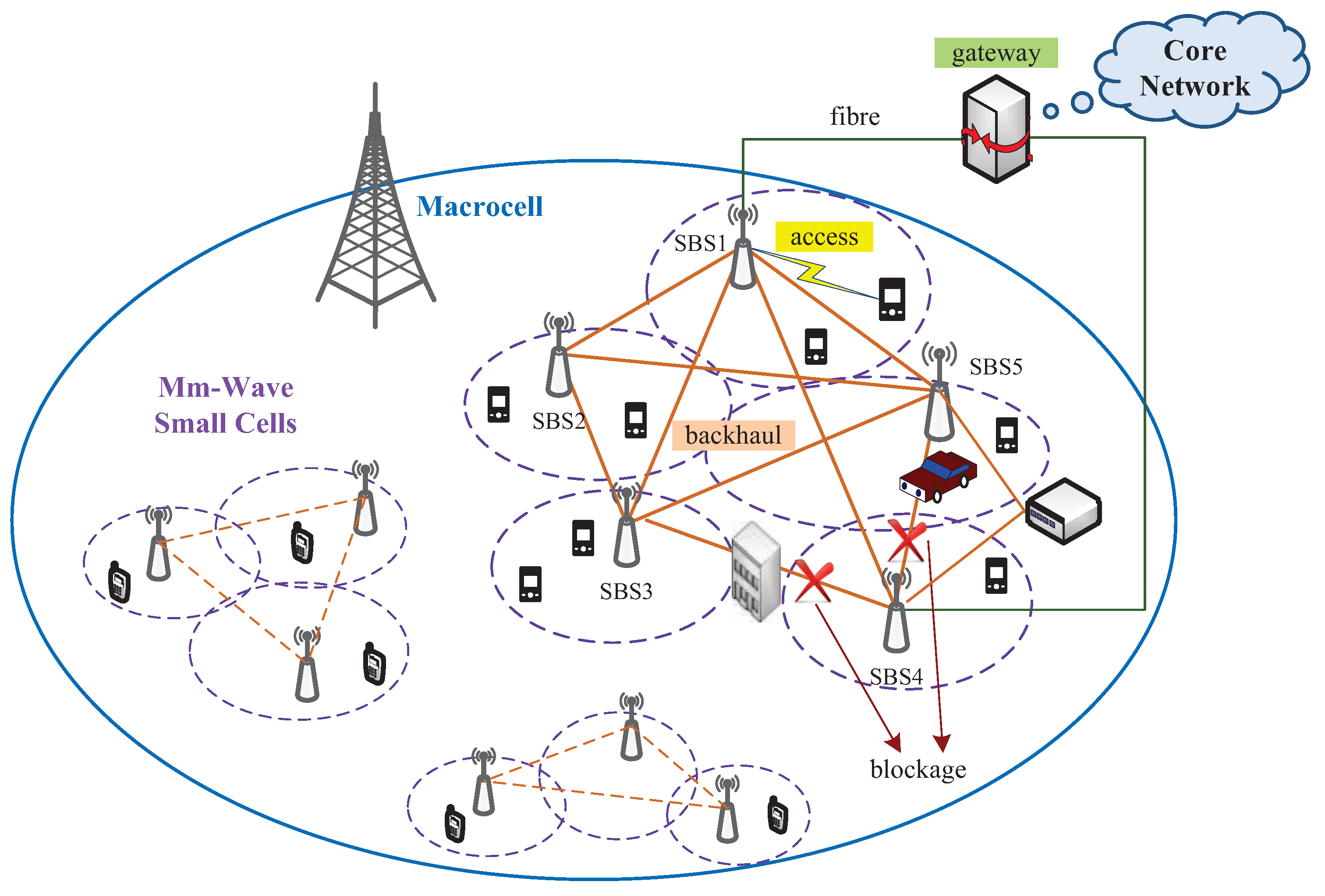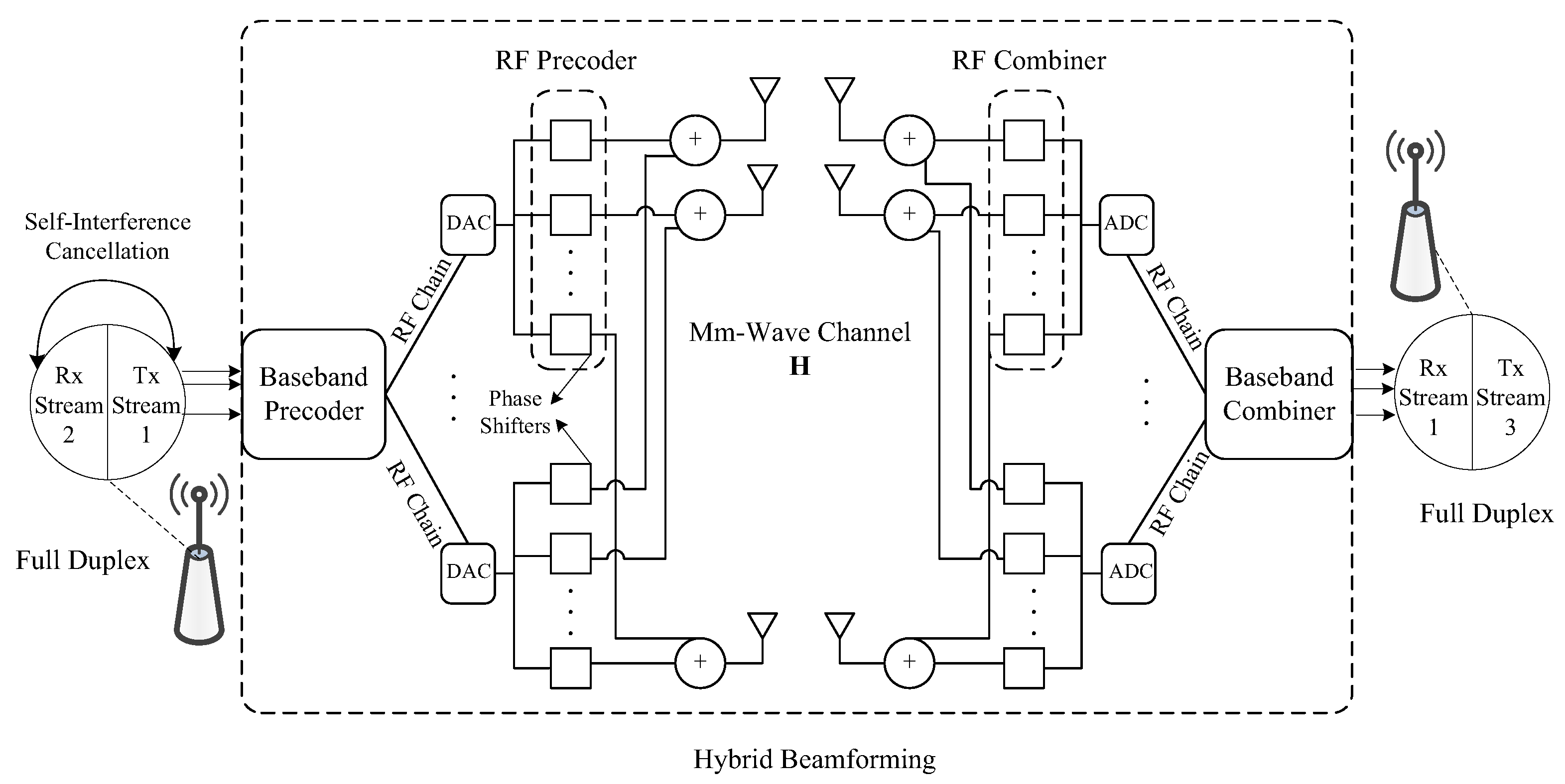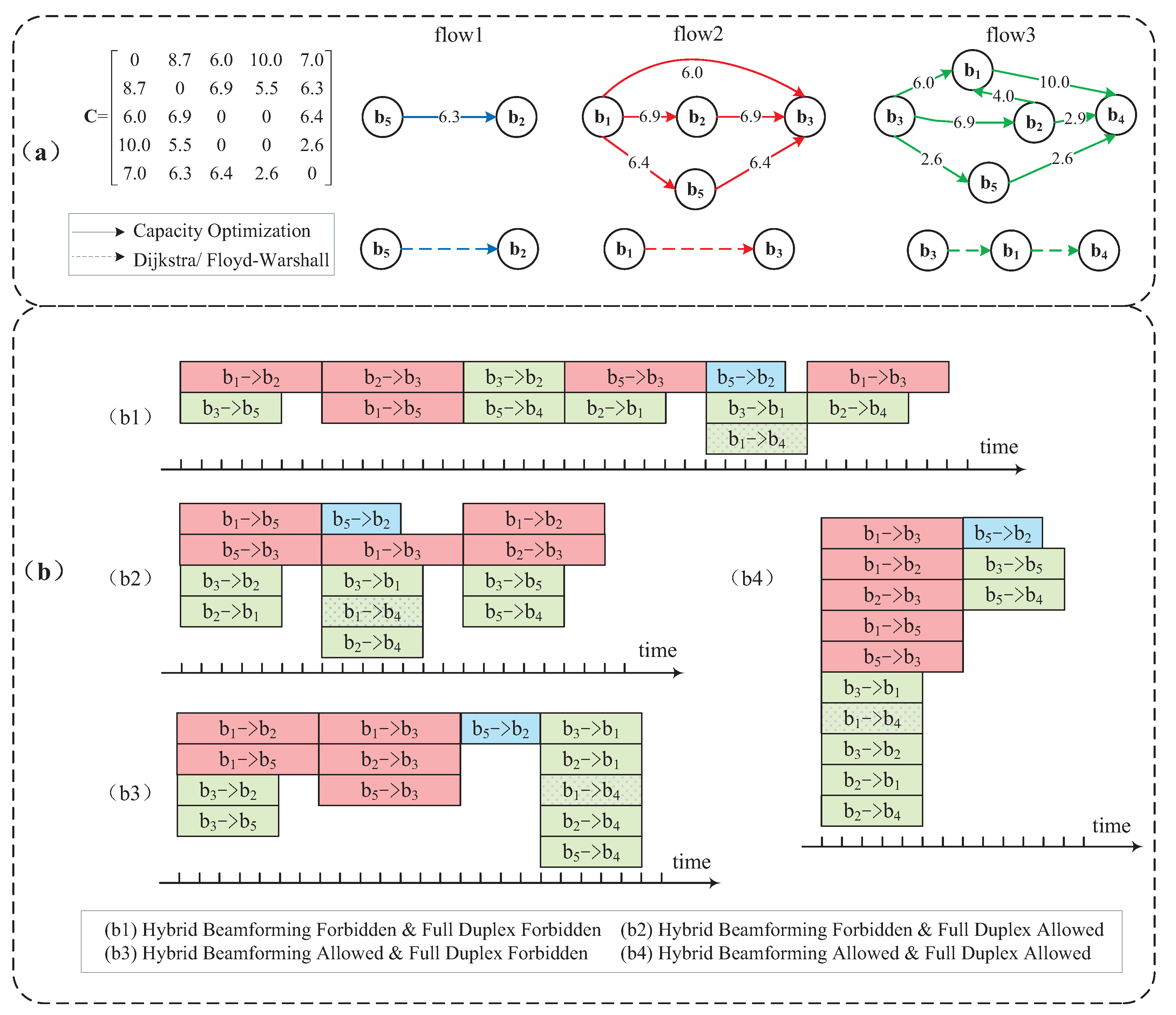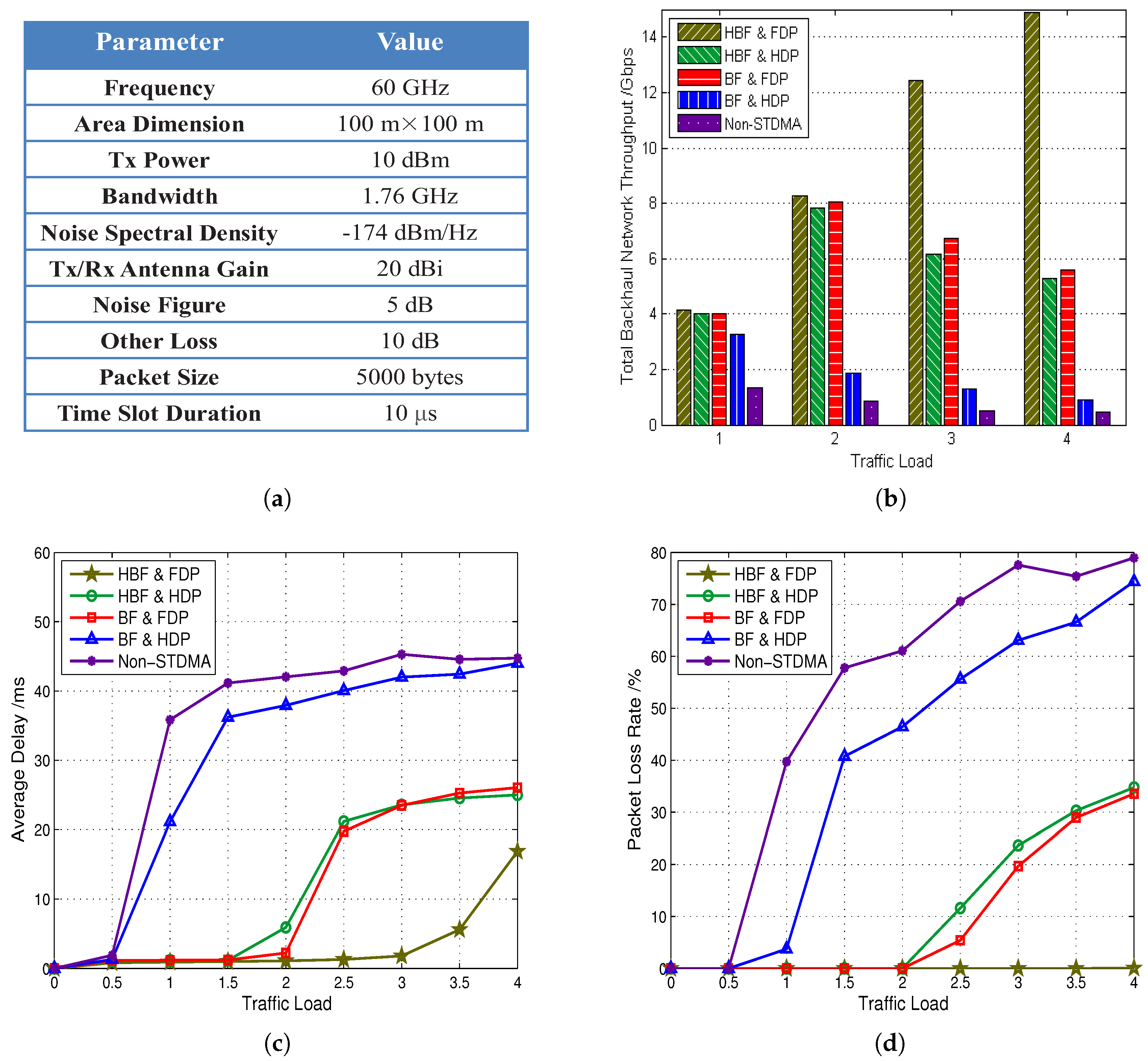Millimetre-Wave Backhaul for 5G Networks: Challenges and Solutions
Abstract
:1. Introduction
2. Millimetre-Wave Technology: State-of-the-Art and Trends
3. System Overview and Problem Statement
3.1. System Overview
3.2. Challenges and Design Goals
3.2.1. Overcoming Path Loss
3.2.2. Efficient Spatial Reuse
3.2.3. Dynamic Link Establishment
4. Emerging Mm-Wave Physical Layer Techniques
4.1. Hybrid Beamforming
4.2. Full Duplex Transceiver
5. Framework Design for 5G Mm-Wave Backhaul
5.1. MAC Layer Procedure
5.2. Transmission Path Selection
- Device and channel constraint: We define a binary variable to indicate that sends data to of the k-th flow if it equals one, and otherwise, it is zero. The relation between and transmission rate is shown as Constraint (2a). Transmission cycles should be avoided in the routing, which means that and cannot be both activated to one (Constraint (2b)). Since multi-stream multiplexing is available in mm-wave backhauling, an SBS may route data streams through multiple separate relays to the destination. However, to avoid a device becoming extremely congested, the number of wireless data streams from one device should better be restricted by the number of RF chains available at the device, shown in Constraint (2c), where is a function of the number of available RF chains. For example, the number of streams may be restricted to be no more than twice the number of RF chains if there are not many requested flows in the system, where . However, if the link between and is connected by fibre, it is excluded from Constraint (2c).
- Flow constraint: For each flow, the outgoing data from the source and the incoming data to the destination must be larger than zero (Constraint (2d)). Meanwhile, there should be no incoming data to the source or outgoing data from the destination for every flow (Constraint (2e)). If full duplex is adopted, a relay may receive and transfer data simultaneously. For an SBS that is neither the source nor the destination of a specific flow, the incoming amount of data to the SBS and the outgoing amount of data from the SBS should be equal, which is depicted in Constraint (2f). Constraint (2g) shows that for any two SBSs, the total amount of data transmitted between them is limited by the corresponding link capacity.
5.3. Scheduling
5.3.1. Optimization Model
- Device and channel constraint: In order to reduce the overhead brought by beam training and switching, we assume that each hop of a new flow would only be transmitted once, as shown in Constraint (4a). In each phase, both the scheduled numbers of incoming links to an SBS and outgoing links from an SBS should not exceed the number of RF chains, while wired links are excluded from such constraints. This constraint could be written as (4b), where and stand for wireless links with SBS as the transmitter and the receiver, respectively. Constraint (4c) shows that if there exists severe interferences between two specific links, e.g., the links corresponding to the -th hop of the -th new flow and the -th hop of the -th new flow, both of the links should not be activated at the same time. Set refers to interference set. If the SINR value of at least one link is below a certain threshold when two links transmit simultaneously, these two links become an element in set .
- Traffic and time constraint: Constraint (4d) shows that the time demand for the n-th hop of the m-th new flow, calculated from the data demands () and transmission rate () achieved by routing, should be no larger than its scheduled transmission time. For a specific new flow, the -th hop could not be scheduled ahead of the -th hop, for , due to the relaying sequencing, shown in Constraint (4e). The full duplex techniques may enable a group of consecutive hops of a new flow to be transmitted in the same phase, which is exempted from half-duplex-related constraints in conventional scheduling problems.
5.3.2. Algorithm and Solution
6. Case Study and Performance Evaluation
7. Conclusions
Acknowledgments
Author Contributions
Conflicts of Interest
References
- Jungnickel, V.; Manolakis, K.; Zirwas, W.; Panzner, B.; Braun, V.; Lossow, M.; Sternad, M.; Apelföjd, R.; Svensson, T. The role of small cells, coordinated multipoint, and massive MIMO in 5G. IEEE Commun. Mag. 2014, 52, 44–51. [Google Scholar] [CrossRef]
- Shakir, M.Z.; Alouini, M.-S. On the area spectral efficiency improvement of heterogeneous network by exploiting the integration of macro-femto cellular networks. In Proceedings of the 2012 IEEE International Conference on Communications (ICC), Ottawa, ON, Canada, 10–15 June 2012; pp. 5695–5700.
- Shakir, M.Z.; Qaraqe, K.A.; Tabassum, H.; Alouini, M.-S.; Serpedin, E.; Imran, M.A. Green heterogeneous small-cell networks: Toward reducing the CO2 emissions of mobile communications industry using uplink power adaptation. IEEE Commun. Mag. 2013, 51, 52–61. [Google Scholar] [CrossRef]
- Ge, X.; Cheng, H.; Guizani, M.; Han, T. 5G wireless backhaul networks: Challenges and research advances. IEEE Netw. 2014, 28, 6–11. [Google Scholar] [CrossRef]
- Yong, S.-K.; Xia, P.; Valdes-Garcia, A. 60 GHz Technology for Gbps WLAN and WPAN: From Theory to Practice; Wiley: Chichester, UK, 2011. [Google Scholar]
- Nie, S.; MacCartney, G.R.; Sun, S.; Rappaport, T.S. 28 GHz and 73 GHz signal outage study for millimetre wave cellular and backhaul communications. In Proceedings of 2014 IEEE International Conference on Communications (ICC), Sydney, Australia, 10–14 June 2014; pp. 4856–4861.
- Zhu, Y.; Zhang, Z.; Marzi, Z.; Nelson, C.; Madhow, U.; Zhao, B.Y.; Zheng, H. Demystifying 60 GHz outdoor picocells. In Proceedings of the 20th Annual International Conference on Mobile Computing and Networking, Maui, HA, USA, 7–11 September 2014; pp. 5–16.
- Roh, W.; Seol, J.-Y.; Park, J.; Lee, B.; Lee, J.; Kim, Y.; Cho, J.; Cheun, K.; Aryanfar, F. Millimetre-wave beamforming as an enabling technology for 5G cellular communications: Theoretical feasibility and prototype results. IEEE Commun. Mag. 2014, 52, 106–113. [Google Scholar] [CrossRef]
- MiWaveS [Online]. Available online: http://www.miwaves.eublue (accessed on 6 January 2016).
- Choi, S.N.; Kim, J.; Kim, I.G.; Kim, D.J. Development of millimetre-wave communication modem for mobile wireless backhaul. In Proceedings of the 18th IEEE International Symposium on Consumer Electronics (ISCE 2014), Jeju, Korea, 22–25 June 2014; pp. 1–2.
- Niu, Y.; Gao, C.; Li, Y.; Su, L.; Jin, D.; Vasilakos, A.V. Exploiting Device-to-Device Communications in Joint Scheduling of Access and Backhaul for mmWave Small Cells. IEEE J. Sel. Areas Commun. 2015, 33, 2052–2069. [Google Scholar] [CrossRef]
- Gao, Z.; Dai, L.; Mi, D.; Wang, Z.; Imran, M.A.; Shakir, A.M. MmWave massive-MIMO-based wireless backhaul for the 5G ultra-dense network. IEEE Wirel. Commun. 2015, 22, 13–21. [Google Scholar] [CrossRef]
- Dehos, C.; Gonzalez, J.L.; Domenico, A.D.; Ktenas, D.; Dussopt, L. Millimetre-wave access and backhauling: The solution to the exponential data traffic increase in 5G mobile communications systems? IEEE Commun. Mag. 2014, 52, 88–95. [Google Scholar] [CrossRef]
- Zheng, K.; Zhao, L.; Mei, J.; Dohler, M.; Xiang, W.; Peng, Y. 10 Gb/s hetsnets with millimetre-wave communications: Access and networking-challenges and protocols. IEEE Commun. Mag. 2015, 53, 222–231. [Google Scholar]
- Jia, H.; Chi, B.; Kuang, L.; Yu, X.; Chen, L.; Zhu, W.; Wei, M.; Song, Z.; Wang, Z. Research on CMOS mm-wave circuits and systems for wireless communications. China Commun. 2015, 12, 1–13. [Google Scholar] [CrossRef]
- Sun, S.; Rappaport, T.S.; Heath, R.W.; Nix, A.; Rangan, S. MIMO for millimetre-wave wireless communications: Beamforming, spatial multiplexing, or both? IEEE Commun. Mag. 2014, 52, 110–121. [Google Scholar] [CrossRef]
- Han, S.; I, C.L.; Xu, Z.; Rowell, C. Large-Scale antenna systems with hybrid analogue and digital beamforming for millimetre wave 5G. IEEE Commun. Mag. 2015, 53, 186–194. [Google Scholar] [CrossRef]
- Alkhateeb, A.; Leus, G.; Heath, R.W. Limited feedback hybrid precoding for multi-user millimetre wave systems. IEEE Trans. Wirel. Commun. 2015, 14, 6481–6494. [Google Scholar] [CrossRef]
- Bharadia, D.; McMilin, E.; Katti, S. Full duplex radios. In Proceedings of the ACM SIGCOMM 2013 Conference, Hong Kong, China, 12–16 August 2013; pp. 375–386.
- Rajagopal, S.; Taori, R.; Abu-Surra, S. Self-interference mitigation for in-band mmWave wireless backhaul. In Proceedings of the 2014 IEEE 11th Consumer Communications and Networking Conference (CCNC), Las Vegas, NV, USA, 10–13 January 2014; pp. 551–556.
- Niu, Y.; Li, Y.; Chen, M.; Jin, D.; Chen, S. A cross-layer design for a software-defined millimetre-wave mobile broadband system. IEEE Commun. Mag. 2016, 54, 124–130. [Google Scholar] [CrossRef]
- Kim, J.; Molisch, A.F. Quality-aware millimetre-wave device-to-device multi-hop routing for 5G cellular networks. In Proceedings of the 2014 IEEE International Conference on Communications (ICC), Sydney, Australia, 10–14 June 2014; pp. 5251–5256.
- YALMIP Tutorials @YALMIP wiki [Online]. Available online: http://users.isy.liu.se/johanl/yalmip/pmwiki.php?n=Tutorials.Tutorialsblue (accessed on 20 October 2015).
- Kompella, S.; Mao, S.; Hou, Y.T.; Sherali, H.D. On path selection and rate allocation for video in wireless mesh networks. IEEE/ACM Trans. Netw. 2009, 17, 212–224. [Google Scholar] [CrossRef]
- Son, I.K.; Mao, S.; Gong, M.X.; Li, Y. On frame-based scheduling for directional mmwave WPANs. In Proceedings of the 2012 IEEE INFOCOM, Orlando, FL, USA, 25–30 March 2012; pp. 2149–2157.





| Frequency Band | Path Loss | Oxygen | Rain Attenuation | Coverage with | ||
|---|---|---|---|---|---|---|
| 100 m | 200 m | Absorption | 5 mm/h | 25 mm/h | <20% Outage | |
| 28 GHz (K band) | 50.69 | 53.70 | 0.2 dB/km | 0.9 dB/km | 4.5 dB/km | 200 m |
| 38 GHz (Q band) | 52.02 | 55.03 | 0.15 dB/km | 1.3 dB/km | 7 dB/km | 200 m |
| 60 GHz (V band) | 54.00 | 57.01 | 16 dB/km | 2.2 dB/km | 10 dB/km | 100 m |
| 73 GHz (E band) | 54.85 | 57.86 | 0.45 dB/km | 3 dB/km | 12 dB/km | 200 m |
| Frequency Band | Advantages | Disadvantages | ||||
| 28 GHz | Suffers the least path loss; Low oxygen absorption and rain attenuation. | Lightly licensed; The bandwidth is relatively small. | ||||
| 38 GHz | Relatively less attenuation caused by oxygen absorption and rain. | Less research and applications done. | ||||
| 60 GHz | Unlicensed bands; Large bandwidth to achieve multi-gigabit rate. | Peak point of oxygen absorption; Relatively large rain attenuation. | ||||
| 73 GHz | Small effects of atmospheric absorption. | Large rain attenuation; Large path loss due to high frequency point. | ||||
| Scheme | 5-SBS Backhaul Network | 6-SBS Backhaul Network | ||||
|---|---|---|---|---|---|---|
| 1 Blockage | 2 Blockages | 3 Blockages | 1 Blockage | 2 Blockages | 3 Blockages | |
| Backhaul Network Throughput | ||||||
| HBF and FDP | 14.48 Gbps | 12.43 Gbps | 9.92 Gbps | 15.34 Gbps | 13.54 Gbps | 11.86 Gbps |
| HBF and HDP | 6.50 Gbps | 6.21 Gbps | 3.39 Gbps | 13.25 Gbps | 9.91 Gbps | 6.11 Gbps |
| BF and FDP | 10.36 Gbps | 6.72 Gbps | 3.92 Gbps | 14.83 Gbps | 12.32 Gbps | 6.86 Gbps |
| BF and HDP | 2.43 Gbps | 1.27 Gbps | 0.66 Gbps | 3.74 Gbps | 2.15 Gbps | 0.90 Gbps |
| None-STDMA | 0.98 Gbps | 0.50 Gbps | 0.37 Gbps | 1.71 Gbps | 0.75 Gbps | 0.43 Gbps |
| Average Delay | ||||||
| HBF and FDP | 1.56 ms | 1.80 ms | 3.15 ms | 1.05 ms | 1.14 ms | 1.52 ms |
| HBF and HDP | 23.07 ms | 23.55 ms | 25.23 ms | 15.59 ms | 20.46 ms | 24.23 ms |
| BF and FDP | 20.67 ms | 23.52 ms | 25.64 ms | 3.35 ms | 10.57 ms | 23.05 ms |
| BF and HDP | 41.09 ms | 41.98 ms | 43.48 ms | 30.64 ms | 30.55 ms | 31.14 ms |
| None-STDMA | 43.25 ms | 45.56 ms | 43.80 ms | 31.12 ms | 30.91 ms | 32.49 ms |
| Packet Loss Rate | ||||||
| HBF and FDP | 0% | 0% | 0% | 0% | 0%s | 0% |
| HBF and HDP | 25.61% | 23.28% | 33.10% | 0.16% | 8.09% | 21.98% |
| BF and FDP | 8.69% | 19.72% | 31.28% | 0% | 0% | 19.54% |
| BF and HDP | 56.46% | 63.20% | 71.25% | 45.61% | 57.92% | 67.89% |
| None-STDMA | 68.51% | 77.40% | 73.90% | 53.22% | 72.97% | 76.38% |
© 2016 by the authors; licensee MDPI, Basel, Switzerland. This article is an open access article distributed under the terms and conditions of the Creative Commons Attribution (CC-BY) license (http://creativecommons.org/licenses/by/4.0/).
Share and Cite
Feng, W.; Li, Y.; Jin, D.; Su, L.; Chen, S. Millimetre-Wave Backhaul for 5G Networks: Challenges and Solutions. Sensors 2016, 16, 892. https://doi.org/10.3390/s16060892
Feng W, Li Y, Jin D, Su L, Chen S. Millimetre-Wave Backhaul for 5G Networks: Challenges and Solutions. Sensors. 2016; 16(6):892. https://doi.org/10.3390/s16060892
Chicago/Turabian StyleFeng, Wei, Yong Li, Depeng Jin, Li Su, and Sheng Chen. 2016. "Millimetre-Wave Backhaul for 5G Networks: Challenges and Solutions" Sensors 16, no. 6: 892. https://doi.org/10.3390/s16060892






